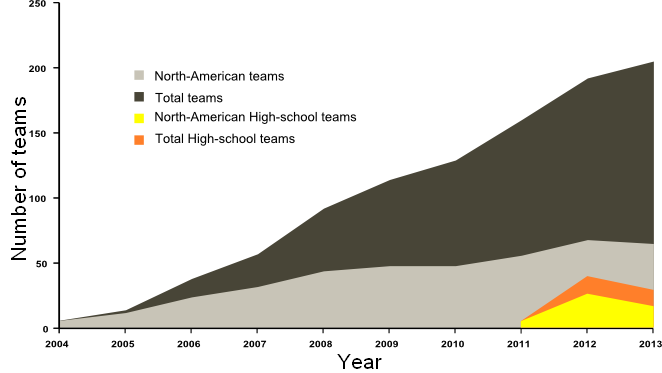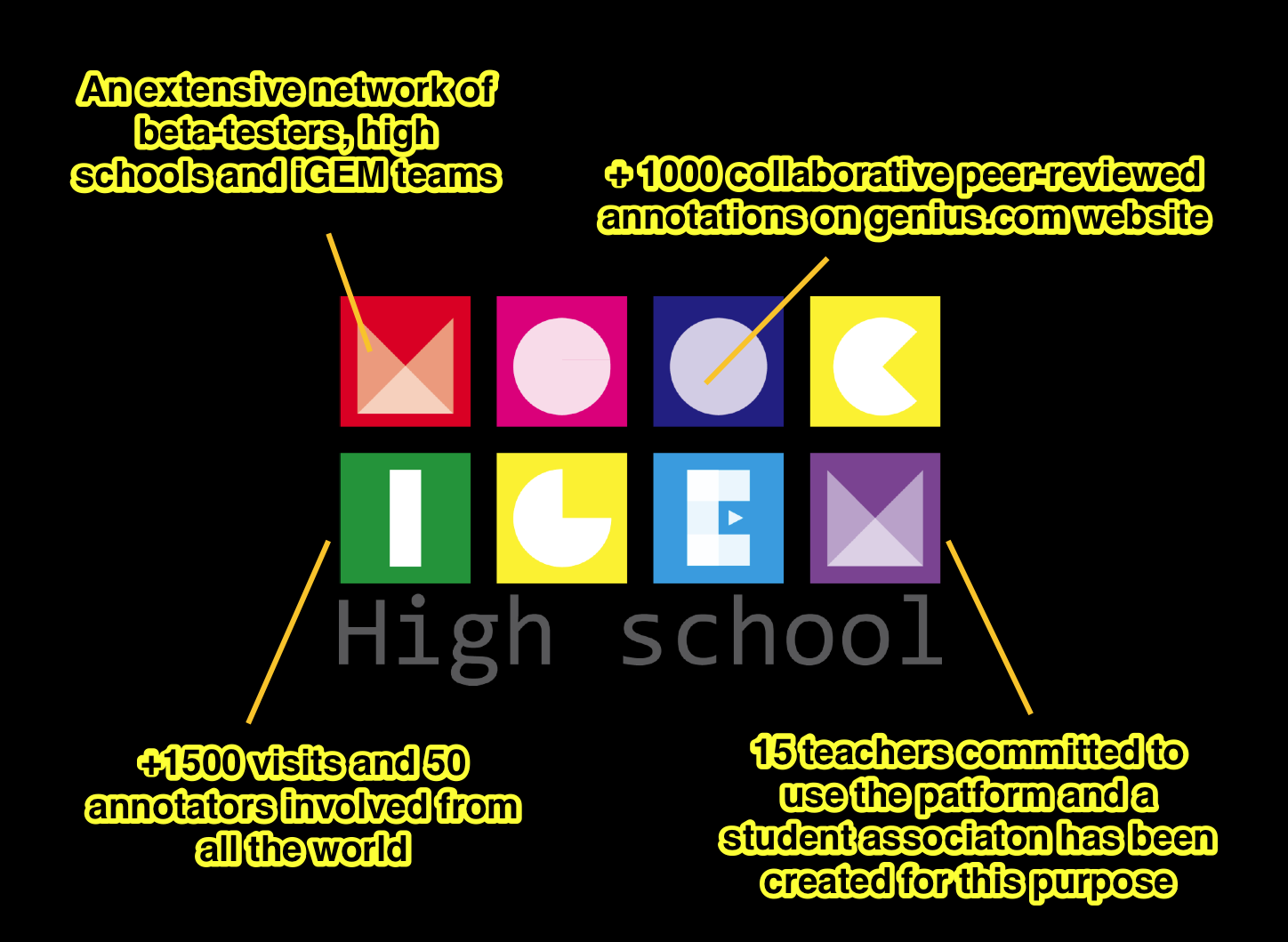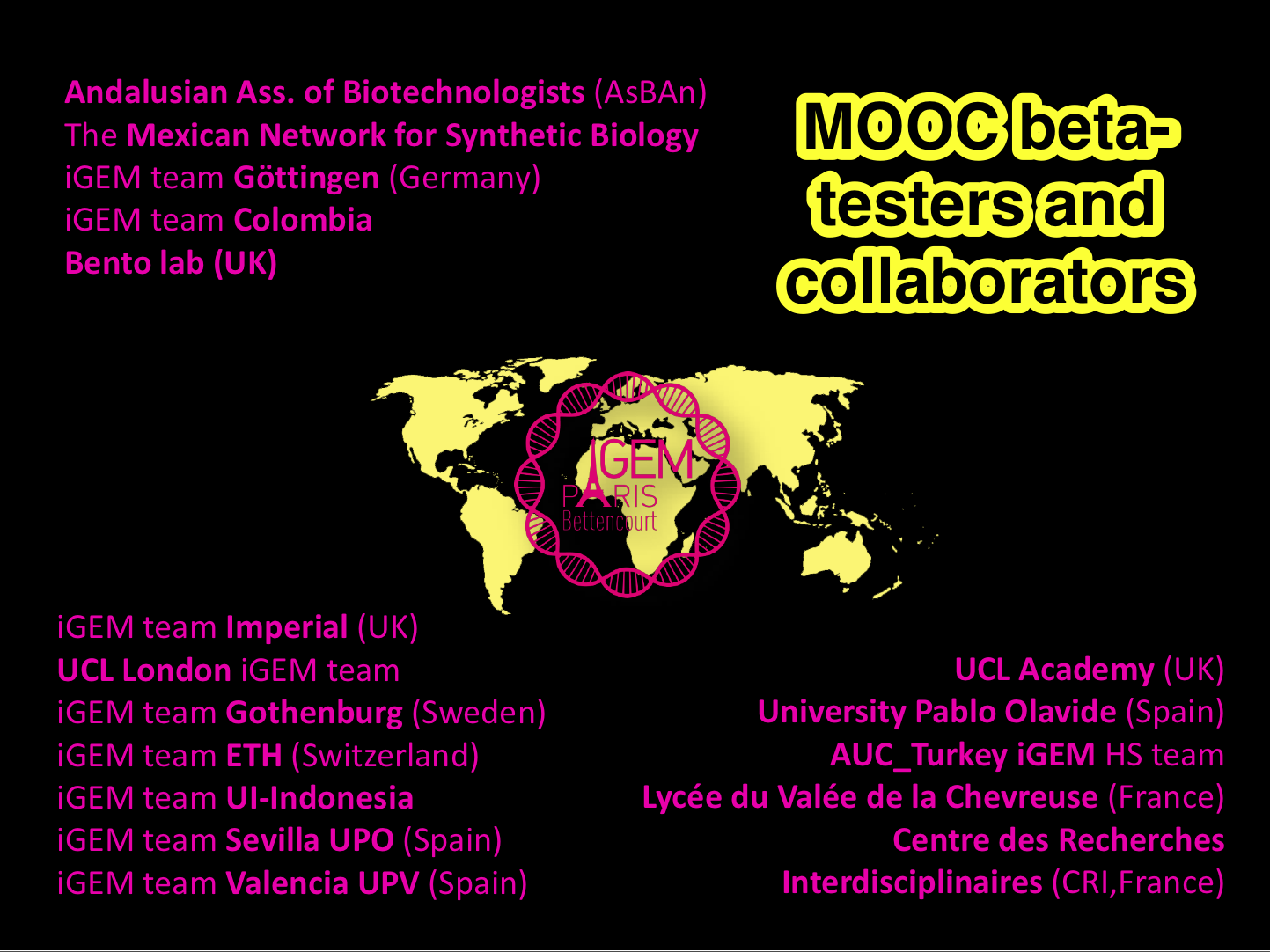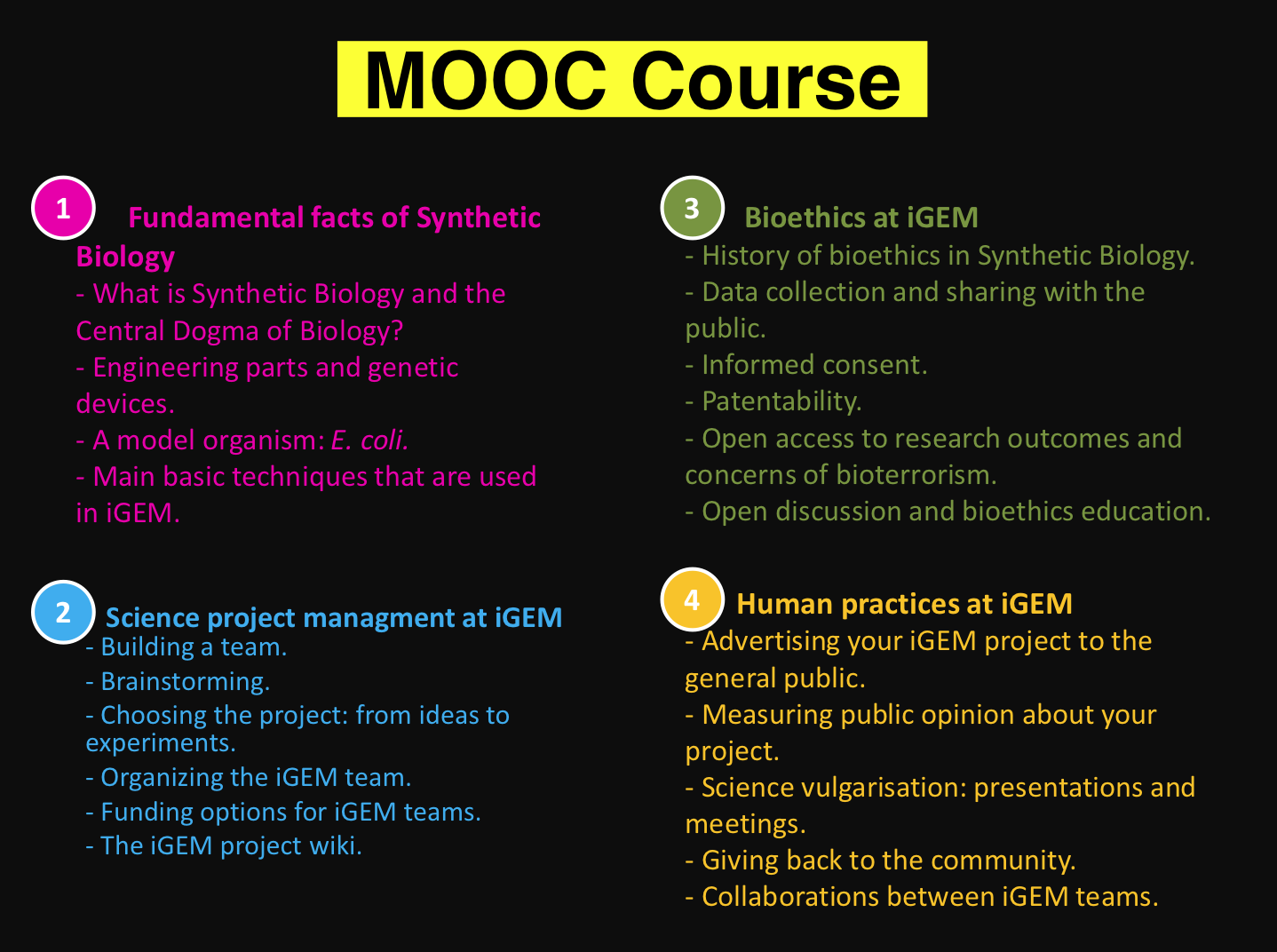Team:Paris Bettencourt/MOOC
From 2014.igem.org
| (131 intermediate revisions not shown) | |||
| Line 13: | Line 13: | ||
background-size : cover; | background-size : cover; | ||
background-color : transparent; | background-color : transparent; | ||
| - | |||
| - | |||
| - | |||
| - | |||
| - | |||
| - | |||
} | } | ||
h6 { | h6 { | ||
| Line 59: | Line 53: | ||
} | } | ||
.division .text1 { | .division .text1 { | ||
| - | + | display : inline-block; | |
| - | + | vertical-align : middle; | |
| - | + | position : relative; | |
| - | + | width : 43%; | |
| - | + | margin-left : 4%; | |
| - | + | font-size : 15px; | |
| + | float : left; | ||
| + | |||
} | } | ||
.division .text2 { | .division .text2 { | ||
| - | + | float : right; | |
| - | + | width : 43%; | |
| - | + | margin-right : 4%; | |
| - | + | font-size : 15px; | |
| - | + | ||
| - | + | ||
} | } | ||
| + | .division .text2 img { | ||
| + | width : 100%; | ||
| + | } | ||
| + | .division .text1 img { | ||
| + | width : 100%; | ||
| + | } | ||
#website { | #website { | ||
width : 90%; | width : 90%; | ||
height : 700px; | height : 700px; | ||
| - | left : 5%; | + | margin-left : 5%; |
} | } | ||
.nameimg { | .nameimg { | ||
| Line 106: | Line 106: | ||
color : rgb(0,0,0); | color : rgb(0,0,0); | ||
} | } | ||
| + | #fond { | ||
| + | width : 100% | ||
| + | height : 300px; | ||
| + | background : rgb(255,0,99); | ||
| + | } | ||
| + | #headtable { | ||
| + | width : 92.5%; | ||
| + | height : 300px; | ||
| + | text-align : adjust; | ||
| + | background : rgb(255,0,99); | ||
| + | margin-right : 3.75%; | ||
| + | margin-left : 3.75%; | ||
| + | } | ||
| + | #headtable tr td { | ||
| + | width : 33.333%; | ||
| + | heigth : 100%; | ||
| + | color : rgb(255,255,255); | ||
| + | font-size : 14px; | ||
| + | } | ||
| + | #headtable tr td b { | ||
| + | font-size : 18px; | ||
| + | } | ||
| + | #fond ul { | ||
| + | list-style-image : url("https://static.igem.org/mediawiki/2014/f/f2/MicodonPB.png"); | ||
| + | } | ||
| + | #intro { | ||
| + | height : 500px; | ||
| + | } | ||
| + | #fullpage { | ||
| + | width : 90%; | ||
| + | margin-left : 5%; | ||
| + | } | ||
| + | #fullpage img { | ||
| + | width : 100%; | ||
| + | } | ||
</style> | </style> | ||
<body> | <body> | ||
| Line 112: | Line 147: | ||
<img src="https://static.igem.org/mediawiki/2014/9/95/PB14mooc.png" class=nameimg> | <img src="https://static.igem.org/mediawiki/2014/9/95/PB14mooc.png" class=nameimg> | ||
</div> | </div> | ||
| - | + | <div id=fond> | |
| - | </ | + | <table id=headtable> |
| - | </div> | + | <tr> |
| + | <td><b><center>BACKGROUND</center></b></br><br> | ||
| + | <p class=text1>Although the iGEM competition for high schools has existed since 2011, there has been low involvement around the world. We believe that many students would be interested in participating but do not know that the competition exists or are unsure about starting an iGEM team. Most of the high school lack the resources, funding or contacts with research labs to start a research project around synthetic biology.</p></td> | ||
| + | <td><b><center>AIMS</center></b></br><br> | ||
| + | <p class=text1><ul style="list-style-type:square"> | ||
| + | The main objective is to promote the iGEM High School competition. We want to create an easy-to-use and cohesive platform that encapsulates video, text and interactive tools. | ||
| + | Moreover, by this, promoting Synthetic Biology education and developing a dynamic community and network able to support the platform after the 2014 Jamboree | ||
| + | </ul> </p></td> | ||
| + | <td><b><center>ACHIEVEMENTS</center></b></br><br> | ||
| + | <p class=text1><ul style="list-style-type:square"> | ||
| + | <li>Created a MOOC with 21 lessons to help high school students build a team</li> | ||
| + | <li>More than 50 people annotated text in Genius and 15 teachers will use the tool next year | ||
| + | <li>20 organizations and iGEM teams around the world have agreed to promote it</li> | ||
| + | <li>A student club was created in CRI (Paris) to continue the support for MOOC iGEM HS</li> | ||
| + | </ul> </p></td> | ||
| + | </tr> | ||
| + | </table> | ||
| + | </div> | ||
<div id=moocdiv> | <div id=moocdiv> | ||
<table> | <table> | ||
<tr> | <tr> | ||
| - | + | <td><a href="#ccl"><p>Achievements</p></a></td> | |
| - | + | <td><a href="#intro"><p>Introduction</p></a></td> | |
| - | <td><a href="# | + | <td><a href="#course"><p>What is MOOC iGEM HS?</p></a></td> |
| - | <td><a href="# | + | <td><a href="#course"><p>MOOC course</p></a></td> |
| - | <td><a href="# | + | <td><a href="#network"><p>MOOC Network</p></a></td> |
| + | |||
</tr> | </tr> | ||
</table> | </table> | ||
</div> | </div> | ||
| - | + | <div id=fullpage><img src="https://static.igem.org/mediawiki/2014/9/98/Screen_Shot_2014-10-17_at_23.16.48.png"></br> | |
| - | + | <b>Screenshot of the MOOC iGEM High School platform.</b> The MOOC website groups all the texts, links and event announcements. <a href="http://igemhs.wix.com/mooc">To visit our page click here.</a> </br></br></div> | |
| - | + | ||
| - | <p class= | + | <div class=division id=intro> |
| + | <p class=text2><img src="https://static.igem.org/mediawiki/2014/2/2d/Teams_PB.png"><b>Figure 1. The iGEM HS competition does not follow the same trend as iGEM college.</b><p> | ||
| + | |||
</p> | </p> | ||
| + | <h6>Introduction</h6> | ||
| + | <p class=text1> </b>iGEM started in 2004 as a course to teach students synthetic biology at MIT. It has since evolved into a summer competition for college students and in 2011 a iGEM High School division was created. Although the college competition has become more successful over time, this is still not the case for the High Shcool competition (Fig. 1).</br></br> | ||
| + | |||
| + | Many students would be interested in participating but do not know about the iGEM competition for Highs Schools or how to start a team at their school. There are limitations that make it harder to participate in the competition, such as the expense of consumables and registration fees or the lack of time or the appropriate lab facilities.<br><br> | ||
| + | |||
| + | To encourage more teams to participate in iGEM HS and spread Synthetic Biology, the iGEM Paris Bettencourt 2014 team has developed the <b>MOOC iGEM High School.</b> | ||
| + | </p> | ||
</div> | </div> | ||
<div class=division id=course> | <div class=division id=course> | ||
| - | <p class=text2>< | + | <p class=text2><a href="http://igemhs.wix.com/mooc"><img src="https://static.igem.org/mediawiki/2014/8/84/Screen_Shot_2014-10-18_at_05.07.44.png"></a> |
| - | + | <b>Figure 2. The MOOC is a complete approach to support High School science and iGEM HS.</b> <br/> <br/> <br/> | |
| - | + | <p> | |
| - | + | ||
| - | + | ||
| - | + | ||
| - | + | ||
| - | + | ||
| - | <b> | + | |
| - | + | ||
| - | + | ||
| - | + | ||
| - | + | ||
| - | < | + | |
| - | + | ||
</p> | </p> | ||
| - | + | <h6>What is MOOC iGEM HS?</h6></b> | |
| - | + | <p class=text1>MOOC iGEM HS is a platform that covers the topics necessary to create an iGEM High School team. We have developed a <b>network</b> to support High Schools with advice and support for common issues such as organization (Fig. 2). | |
| - | <b> | + | </br></br> |
| - | + | <b> Massive Open Online Course (MOOC)</b></br> | |
| - | + | The Massive Open Online Course is composed by texts covering important topics for starting an iGEM team. They can be found at <b>Genius.com</b>, a collaborative annotating website. Audiovisual material in <b>English</b>, <b>French</b> and <b>Spanish</b> is provided for each topic. So far, the MOOC includes <b>21 topics</b> distributed over 4 different areas: Fundamental facts of synthetic Biology, Bioethics at iGEM, Science project at iGEM, and Human | |
| - | < | + | practices at iGEM.</p> |
| - | < | + | </br></br> |
| - | + | </div> | |
| - | < | + | <div class=division> |
| - | <b> | + | <p class=text2><a href="http://igemhs.wix.com/mooc"><img src="https://static.igem.org/mediawiki/2014/2/21/Screen_Shot_2014-10-18_at_05.08.02.png"></a> |
| - | + | <b>Figure 3. An extensive network has been created to support the platform (Fig. 3).</b> <br/> <br/> <br/> | |
| - | < | + | <p> |
| - | + | ||
| - | < | + | |
| - | < | + | |
| - | + | ||
| - | < | + | |
</p> | </p> | ||
| + | <h6>MOOC iGEM HS network</h6> | ||
| + | <p class=text1> | ||
| + | </br> | ||
| + | Many iGEM Practices & Policy projects (former Human Practices) are not continued after the competition. We plan for this tool to be used and improved by other iGEM teams in the future. For this aim, we have built a network of organizations, people and institutions from all around the world interested in helping and supporting high schools teams of their area (Fig. 3).</p> | ||
| + | |||
| + | <br/> | ||
| + | </p> | ||
| + | </div> | ||
| + | <div class=division> | ||
| + | <p class=text2><a href="http://igemhs.wix.com/mooc"><img src="https://static.igem.org/mediawiki/2014/3/3c/Screen_Shot_2014-10-18_at_05.07.55.png"></a> | ||
| + | <b>Figure 4. The course supports four key components of an iGEM project.</b> <br/> <br/> <br/> | ||
| + | <p> | ||
| + | </p> | ||
| + | <h6>MOOC course</h6> | ||
| + | <p class=text1> | ||
| + | As mentioned before, we developed a course on the Genius platform. The Genius pages so far has more than 50 contributors, more than 1500 visits and more than 1000 activity events (annotations, likes, comments, annotation edits). This platform and outreach approach has little precedence among iGEM projects and will contribute greatly to the synthetic biology and scientific community. This success was possible thanks to the MOOC network and the MOOC iGEM HS beta testers.</br></br> | ||
| + | The Genius platform allow the users to interact by rating the annotations from other users or leaving suggestions. Genius incorporates a reward system: users win IQ points as they interact, annotate, or add new pages. This creates a ranking of users per page, per tag (for example, MOOC iGEM HS), sorting them by their IQ. Users don’t have the same type of account, depending on their level of authority. For instance, teachers have educator accounts that allow them to make changes of the annotations made in their texts and create classroom pages. For our MOOC, we have to approve every annotation to make it “official”, although it is made public from the moment it has been made. Teachers found this feature to be a powerful tool to create assignments and follow the learning process of their students in a more cohesive manner.</br></br> | ||
| + | Each lesson is supplemented with a video, in which a narrator reads the text while the content is drawn in an easy to understand whiteboard format. The videos were available online with subtitles in French and Spanish. An outline of the lessons in described below (Fig. 4)</p> | ||
| + | </div> | ||
| + | </br></br> | ||
| + | <div class=division> | ||
| + | <p class=text2><a href="http://igemhs.wix.com/mooc"><img src="https://static.igem.org/mediawiki/2014/8/8d/Screen_Shot_2014-10-18_at_05.08.09.png"></a> | ||
| + | <b>Figure 5. The feedback from high schoolers and young students has been overall positive and support our approach.</b> <br/> <br/> <br/> | ||
| + | <p> | ||
| + | </p> | ||
| + | <h6>MOOC Network</h6> | ||
| + | <p class=text1> Many of our efforts were focused on developing a solid network of users ready to continue the project after iGEM Jamboree 2014 is over. </br></br><b>High school work</b></br>We are collaborating with <b>Lycée du Valée de la Chevreuse</b> as a prototype for starting more HS igem teams: the <b>Biobuilder</b> program will start there next year and the MOOC iGEM HS will be used to complement their Synthetic Biology classes. More than <b>15 high school teachers</b> are currently working to include MOOC High School in their curiculum. Before launching the MOOC, we tested the platform with four classes.</br></br> We received feedback from students and teachers about how to improve our course (Fig. 5). Because iGEM is an international competition we wanted to be able to reach students around the world. Therefore we made our MOOC is <b>multilingual</b> and we held several workshops in October to reach a total of <b>90 high school students</b> in Seville during the "Week of Science" fair in the University Pablo Olavide. | ||
| + | </br></br> <b>Student network and biohack spaces</b></br> In order to continue this project, we have created a student association in the CRI (Paris) Thanks to <b>biohack spaces</b> and specially to the start-up <b>Bento lab</b>, we will be able to provide basic lab material for high schools that have no access to research labs. Many other iGEM teams and synthetic biology organizations have expressed their support to MOOC iGEM HS and committed to participate in its development during the following year. | ||
| + | |||
| + | </br></br></br></br></br></br> | ||
| + | |||
| + | </p> | ||
| + | </div> | ||
</div> | </div> | ||
| - | |||
| - | |||
| - | |||
| - | |||
| - | |||
| - | |||
| - | |||
| - | |||
| - | |||
| - | |||
| - | |||
| - | |||
| - | |||
| - | |||
| - | |||
| - | |||
| - | |||
</body> | </body> | ||
</html> | </html> | ||
{{:Team:Paris_Bettencourt/Footer}} | {{:Team:Paris_Bettencourt/Footer}} | ||
Latest revision as of 03:41, 18 October 2014

Although the iGEM competition for high schools has existed since 2011, there has been low involvement around the world. We believe that many students would be interested in participating but do not know that the competition exists or are unsure about starting an iGEM team. Most of the high school lack the resources, funding or contacts with research labs to start a research project around synthetic biology. |
|
|
 Screenshot of the MOOC iGEM High School platform. The MOOC website groups all the texts, links and event announcements. To visit our page click here.
Screenshot of the MOOC iGEM High School platform. The MOOC website groups all the texts, links and event announcements. To visit our page click here.  Figure 1. The iGEM HS competition does not follow the same trend as iGEM college.
Figure 1. The iGEM HS competition does not follow the same trend as iGEM college.
Introduction
iGEM started in 2004 as a course to teach students synthetic biology at MIT. It has since evolved into a summer competition for college students and in 2011 a iGEM High School division was created. Although the college competition has become more successful over time, this is still not the case for the High Shcool competition (Fig. 1).
Many students would be interested in participating but do not know about the iGEM competition for Highs Schools or how to start a team at their school. There are limitations that make it harder to participate in the competition, such as the expense of consumables and registration fees or the lack of time or the appropriate lab facilities.
To encourage more teams to participate in iGEM HS and spread Synthetic Biology, the iGEM Paris Bettencourt 2014 team has developed the MOOC iGEM High School.
 Figure 2. The MOOC is a complete approach to support High School science and iGEM HS.
Figure 2. The MOOC is a complete approach to support High School science and iGEM HS.
What is MOOC iGEM HS?
MOOC iGEM HS is a platform that covers the topics necessary to create an iGEM High School team. We have developed a network to support High Schools with advice and support for common issues such as organization (Fig. 2). Massive Open Online Course (MOOC) The Massive Open Online Course is composed by texts covering important topics for starting an iGEM team. They can be found at Genius.com, a collaborative annotating website. Audiovisual material in English, French and Spanish is provided for each topic. So far, the MOOC includes 21 topics distributed over 4 different areas: Fundamental facts of synthetic Biology, Bioethics at iGEM, Science project at iGEM, and Human practices at iGEM.
 Figure 3. An extensive network has been created to support the platform (Fig. 3).
Figure 3. An extensive network has been created to support the platform (Fig. 3).
MOOC iGEM HS network
Many iGEM Practices & Policy projects (former Human Practices) are not continued after the competition. We plan for this tool to be used and improved by other iGEM teams in the future. For this aim, we have built a network of organizations, people and institutions from all around the world interested in helping and supporting high schools teams of their area (Fig. 3).
 Figure 4. The course supports four key components of an iGEM project.
Figure 4. The course supports four key components of an iGEM project.
MOOC course
As mentioned before, we developed a course on the Genius platform. The Genius pages so far has more than 50 contributors, more than 1500 visits and more than 1000 activity events (annotations, likes, comments, annotation edits). This platform and outreach approach has little precedence among iGEM projects and will contribute greatly to the synthetic biology and scientific community. This success was possible thanks to the MOOC network and the MOOC iGEM HS beta testers. The Genius platform allow the users to interact by rating the annotations from other users or leaving suggestions. Genius incorporates a reward system: users win IQ points as they interact, annotate, or add new pages. This creates a ranking of users per page, per tag (for example, MOOC iGEM HS), sorting them by their IQ. Users don’t have the same type of account, depending on their level of authority. For instance, teachers have educator accounts that allow them to make changes of the annotations made in their texts and create classroom pages. For our MOOC, we have to approve every annotation to make it “official”, although it is made public from the moment it has been made. Teachers found this feature to be a powerful tool to create assignments and follow the learning process of their students in a more cohesive manner. Each lesson is supplemented with a video, in which a narrator reads the text while the content is drawn in an easy to understand whiteboard format. The videos were available online with subtitles in French and Spanish. An outline of the lessons in described below (Fig. 4)
 Figure 5. The feedback from high schoolers and young students has been overall positive and support our approach.
Figure 5. The feedback from high schoolers and young students has been overall positive and support our approach.
MOOC Network
Many of our efforts were focused on developing a solid network of users ready to continue the project after iGEM Jamboree 2014 is over. High school workWe are collaborating with Lycée du Valée de la Chevreuse as a prototype for starting more HS igem teams: the Biobuilder program will start there next year and the MOOC iGEM HS will be used to complement their Synthetic Biology classes. More than 15 high school teachers are currently working to include MOOC High School in their curiculum. Before launching the MOOC, we tested the platform with four classes. We received feedback from students and teachers about how to improve our course (Fig. 5). Because iGEM is an international competition we wanted to be able to reach students around the world. Therefore we made our MOOC is multilingual and we held several workshops in October to reach a total of 90 high school students in Seville during the "Week of Science" fair in the University Pablo Olavide. Student network and biohack spaces In order to continue this project, we have created a student association in the CRI (Paris) Thanks to biohack spaces and specially to the start-up Bento lab, we will be able to provide basic lab material for high schools that have no access to research labs. Many other iGEM teams and synthetic biology organizations have expressed their support to MOOC iGEM HS and committed to participate in its development during the following year.
 "
"







 +33 1 44 41 25 22/25
+33 1 44 41 25 22/25


